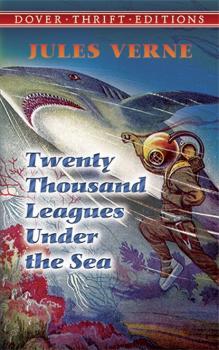Жюль Верн
Список книг автора Жюль ВернJourney to the Center of the Earth (Translated by Frederic Amadeus Malleson)
First published in 1864, “Journey to the Center of the Earth” is Jules Verne’s classic tale of adventure, one of the earliest examples of science fiction. When German professor Otto Liedenbrock finds a coded message in an original runic manuscript of Snorri Sturluson’s Icelandic saga, “Heimskringla,” he discovers what he believes to be a secret passage to the center of the Earth. Professor Liedenbrock, who has long hypothesized that there are volcanic tubes which descend deep into the Earth, embarks immediately for Iceland on a journey of scientific discovery to prove his belief. Along with his reluctant nephew, Alex, and Icelandic guide Hans Bjelke, whom they have hired, the three descend into the bowels of a volcanic crater. A dangerous journey awaits them as they attempt to travel to the center of the Earth. Following a subterranean river to a vast ocean, which they traverse on a raft, they ultimately discover a world filled with prehistoric plants and animals. “Journey to the Center of the Earth” has captivated readers for generations, and remains to this day as one the most fantastical tales ever told. This edition follows the translation of Frederic Amadeus Malleson.
Around the World in Eighty Days (Translated by George Makepeace Towle)
First published in 1873, “Around the World in Eighty Days” is a classic tale of adventure by French author Jules Verne, which tells the story of eccentric English inventor Phileas Fogg and his newly employed French valet Passepartout as they set out to circumnavigate the globe in eighty days. When Fogg gets into an argument at the Reform Club over an article in “The Daily Telegraph,” which posits that the building of a new railway section in India may now make it possible to circle the earth in eighty days, he hastily accepts a wager with his fellow club members to attempt the feat. In a mad dash he hurries off at once, with Passepartout, in a voyage around the world. Encountering many obstacles and misadventures along the way the two must make numerous accommodations when things do not go as planned. Matters are further complicated by the pursuit of a Scotland Yard detective named Fix, who mistakenly believes Fogg to be a bank robber on the run. “Around the World in Eighty Days,” is a classic work of genuine creativity and sheer delight that continues to amuse audiences until this day. This edition follows the translation of George Makepeace Towle.
Twenty Thousand Leagues Under the Sea (Translated by F. P. Walter and Illustrated by Milo Winter)
Originally serialized between March 1869 and June 1870, Jules Verne’s “Twenty Thousand Leagues Under the Sea” is one of the greatest underwater sea adventures of all time. It is the story of Professor Pierre Aronnax who sets off aboard an American frigate to investigate a series of attacks, which has been reported to be made by an amphibious monster. The monster in question is actually the submarine vessel the ‘Nautilus,’ which is commanded by the eccentric Captain Nemo. When the Nautilus destroys the Professor’s ship, he is taken prisoner by Captain Nemo along with his trusted servant Conseil and the frigate’s harpooner Ned Land. What follows for the three is a tale of great adventure and scientific wonder. An early pioneer of science fiction, Jules Verne’s work is noted for its prediction of scientific advancements. In the case of “Twenty Thousand Leagues Under the Sea” Verne accurately forecasted the development of submarine vessels. It is at once a harbinger of technology to come and captivating tale of adventure which has delighted readers ever since its original publication. This edition is translated by F. P. Walter, is illustrated by Milo Winter, and includes a biographical afterword.
Twenty Thousand Leagues Under the Sea
The «man who invented the future,» French novelist Jules Verne fanned mankind's desire to explore earth's hidden territories. His prophetic 1870 adventure novel, featuring a fabulous underwater craft commanded by the brilliant and mysterious Captain Nemo, predated the deep-water submarine.Weaving amazing scientific achievements with simple, everyday occurrences, this memorable tale brims with detailed descriptions of a futuristic vessel and bizarre scenes of life on the ocean's bottom. On-board travelers view Red Sea coral, wrecks of a historic naval battle, Antarctic ice shelves, and the fictional Atlantis. In addition, they confront a giant squid and belligerent cannibals, among other rousing adventures.The crowning achievement of Verne's literary career, Twenty Thousand Leagues Under the Sea not only influenced H. G. Wells and future generations of writers, but also inspired numerous films.
Journey to the Center of the Earth
"The reason Verne is still read by millions today is simply that he was one of the best storytellers who ever lived." — Arthur C. ClarkeAn adventurous geology professor chances upon a manuscript in which a 16th-century explorer claims to have found a route to the earth's core. Professor Lidenbrock can't resist the opportunity to investigate, and with his nephew Axel, he sets off across Iceland in the company of Hans Bjelke, a native guide. The expedition descends into an extinct volcano toward a sunless sea, where they encounter a subterranean world of luminous rocks, antediluvian forests, and fantastic marine life — a living past that holds the secrets to the origins of human existence.Originally published in 1864, Jules Verne's classic remains critically acclaimed for its style and imaginative visions. Verne wrote many fantasy stories that later proved remarkably prescient, and his distinctive combination of realism and romanticism exercised a lasting influence on writers as diverse as Mark Twain, Arthur Conan Doyle, and Jean-Paul Sartre. In addition to the excitement of an action novel, Journey to the Center of the Earth has the added appeal of a psychological quest, in which the sojourn itself is as significant as the ultimate destination.
Around the World in Eighty Days
Taking up a challenge from his whist partners, a mysterious English gentleman named Phileas Fogg wagers half his fortune and abandons his quiet domestic routine to undertake a daring feat: to circle the globe in a mere 80 days, an achievement unheard of in the Victorian world.Fogg and Passepartout, his devoted manservant, avail themselves of virtually every known means of transportation in their wild race against time. All the while, a devious detective dogs their every step and introduces fresh obstacles. The resourceful Fogg faces each new trial with unshakable aplomb, through a constantly shifting background of exotic locales — from the jungles of India, a Chinese opium den, and a Japanese circus to a full-throttle train ride under attack by Sioux and a bloodless mutiny aboard a tramp steamer.The most popular of Jules Verne's fantastic adventure stories, Around the World in Eighty Days first appeared as a newspaper serial in 1872, much to the delight of a world already agog with recent advances in technology. Its enduring blend of comic misadventures and thrilling suspense continues to enchant generations of readers.
Twenty Thousand Leagues Under The Sea
One of the greatest underwater sea adventures of all time, «Twenty Thousand Leagues Under the Sea» is the story of Professor Pierre Aronnax who sets off aboard an American frigate to investigate a series of attacks, which has been reported to be made by an amphibious monster. The monster in question is actually the submarine vessel the Nautilus, which is commanded by the eccentric Captain Nemo. When the Nautilus destroys the Professor's ship, he is taken prisoner by Captain Nemo along with his trusted servant Conseil and the frigate's harpooner Ned Land. What follows for the three is a tale of great adventure and scientific wonder that will delight readers both young and old.
Around the World in Eighty Days
"Around the World in Eighty Days" is one of the greatest adventure novels of all time by one of the greatest of all adventure novel writers, Jules Verne. It is the story of the eccentric English inventor Phileas Fogg who sets out to make it around the world in eighty days in order to win a bet. With his trusted French valet, Passepartout, Fogg hurries off in a mad dash around the world, encountering numerous obstacles and adventures along the way. Jules Verne's classic work, «Around the World in Eighty Days,» still holds up today as a work a genuine creativity and sheer delight.
The Underground City
Jules Gabriel Verne (1828-1905) has been ranked alongside Hugo Gernsback and H.G. Wells for the title of «Father of Science Fiction.» The French novelist wrote about scientific and technological advancements – particularly in air, space and water travel – before they existed. His popular stories of travelers in unknown realms, known as his «voyages extraordinares», have made him the second-most translated author in the world. «The Underground City», one of Verne's lesser known works, begins with coal miner James Starr's journey to an old mine in Aberfoyle, near Stirling, Scotland, and the story spans over ten years. The family of mine overman, Simon Ford, has been living deep inside the mine, where they have discovered a large vein of coal. As a result, a community grows up around an underground lake called Loch Malcolm, 1500 feet below the ground, and soon mysterious and unexplainable events begin to plague the Fords and the townspeople.
A Journey to the Center of the Earth
"A Journey to the Center of the Earth" is one of Jules Verne's best-known works and one of the most classic tales of adventure ever written. It is the story of the German geology professor Otto Lidenbrock who discovers a manuscript from a 16th century explorer who claims to have discovered a passageway that leads to the center of the earth. The professor hastily sets off with his nephew Axel and an Icelandic guide by the name of Hans to find the center of the earth. Great obstacles and wondrous sights await them on their journey.









